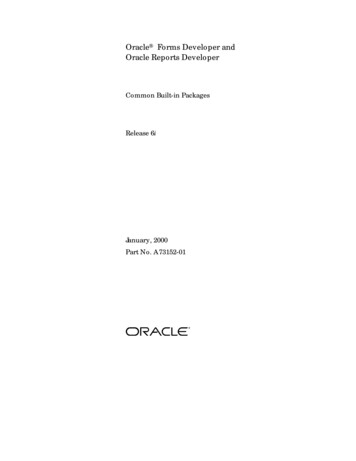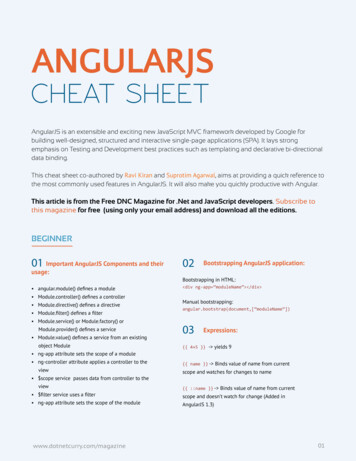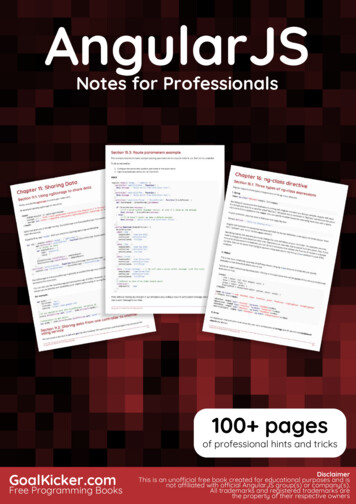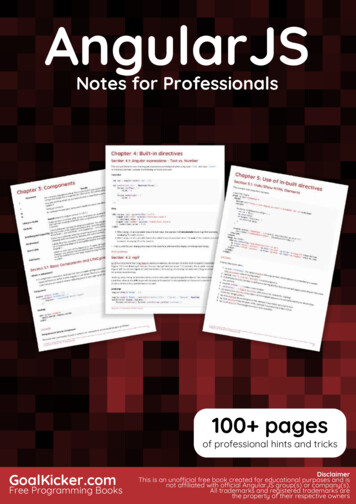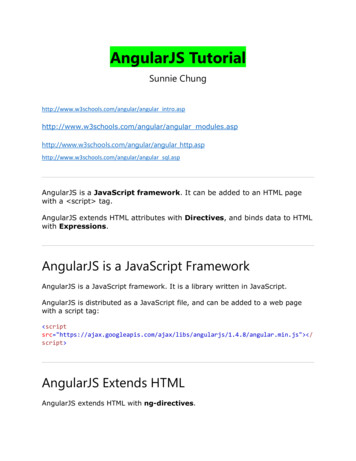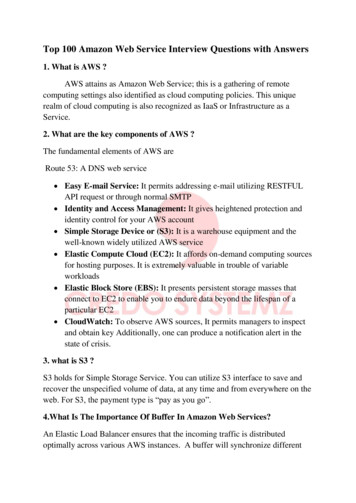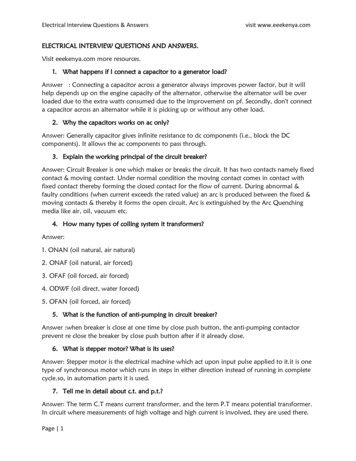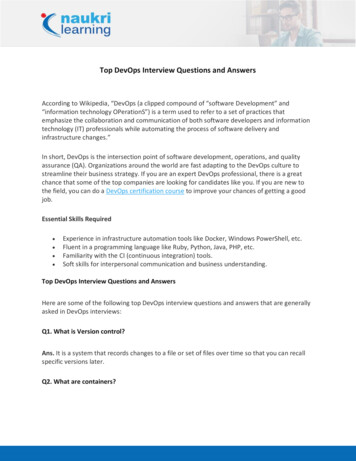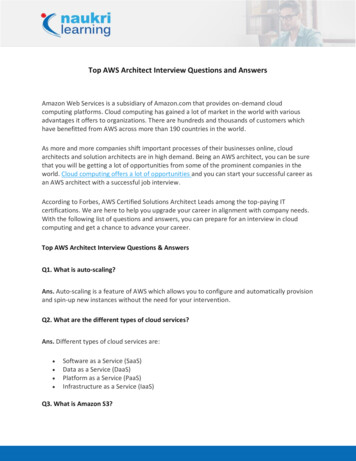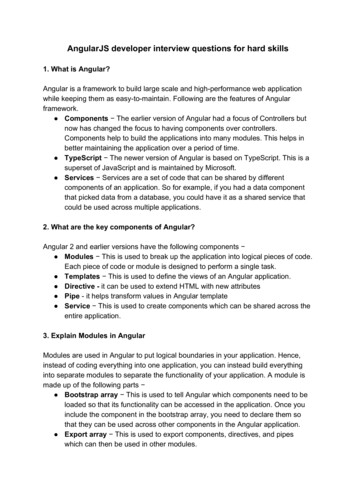
Transcription
AngularJS developer interview questions for hard skills1. What is Angular?Angular is a framework to build large scale and high-performance web applicationwhile keeping them as easy-to-maintain. Following are the features of Angularframework. Components The earlier version of Angular had a focus of Controllers butnow has changed the focus to having components over controllers.Components help to build the applications into many modules. This helps inbetter maintaining the application over a period of time. TypeScript The newer version of Angular is based on TypeScript. This is asuperset of JavaScript and is maintained by Microsoft. Services Services are a set of code that can be shared by differentcomponents of an application. So for example, if you had a data componentthat picked data from a database, you could have it as a shared service thatcould be used across multiple applications.2. What are the key components of Angular?Angular 2 and earlier versions have the following components Modules This is used to break up the application into logical pieces of code.Each piece of code or module is designed to perform a single task. Templates This is used to define the views of an Angular application. Directive - it can be used to extend HTML with new attributes Pipe - it helps transform values in Angular template Service This is used to create components which can be shared across theentire application.3. Explain Modules in AngularModules are used in Angular to put logical boundaries in your application. Hence,instead of coding everything into one application, you can instead build everythinginto separate modules to separate the functionality of your application. A module ismade up of the following parts Bootstrap array This is used to tell Angular which components need to beloaded so that its functionality can be accessed in the application. Once youinclude the component in the bootstrap array, you need to declare them sothat they can be used across other components in the Angular application. Export array This is used to export components, directives, and pipeswhich can then be used in other modules.
Import array Just like the export array, the import array can be used toimport the functionality from other Angular modules.4. Explain Components in AngularEach application consists of Components. Each component is a logical boundary offunctionality for the application. You need to have layered services, which are usedto share the functionality across components. Following is the anatomy of aComponent. A component consists of Class This is like a C or Java class which consists of properties andmethods. Metadata This is used to decorate the class and extend the functionality ofthe class. Template This is used to define the HTML view which is displayed in theapplication.5. What are Angular directives? Explain with examplesA directive is a custom HTML element that is used to extend the power of HTML.Angular 2 has the following directives that get called as part of the BrowserModulemodule. ngIf The ngif element is used to add elements to the HTML code if it evaluates totrue, else it will not add the elements to the HTML code. Syntax *ngIf 'expression' If the expression evaluates to true then the corresponding gets added, elsethe elements are not added. ngFor The ngFor element is used to elements based on the condition of the Forloop. Syntax *ngFor 'let variable of variablelist' The variable is a temporary variable to display the values in the variablelist .6. How will you handle HTTP errors in Angular applications?You can work with HTTP errors if you attach a “ catch” to your request. For example:
import { Injectable } from '@angular/core';import { Observable } from 'rxjs/Observable';import { HttpClient } from '@angular/common/http';import 'rxjs/add/observable/throw';@Injectable()export class Client {constructor(public http: HttpClient) {}public fetch() {return this.http.post('https://thisurliswrong123123.com', {}).catch((err) {// Do messaging and error handling herereturn Observable.throw(err)});}}You should use HTTP Interceptor to route all request properly. And you canautomatically add or remove properties to each request.7. What is routing?Routing helps in directing users to different pages based on the option they chooseon the main page. Hence, based on the option they choose, the required AngularComponent will be rendered to the user.8. What is CLI?Command Line Interface (CLI) can be used to create our Angular application. Italso helps in creating a unit and end-to-end tests for the application.9. What is Dependency Injection?
Dependency injection is an app design pattern. Angular provides a developer with itsown DI framework and it is used to increase the efficiency of Angular apps.Dependencies are services or objects that a class needs to perform its function. DI isa coding pattern in which a class asks for dependencies from external sources ratherthan creating them itself ( Angular.io ).10. Explain tsconfig.json file.This file is used to give the options about TypeScript used for the Angular project.{"compilerOptions" : { "target" : "es5" , "module" : "commonjs" , "moduleResolution" : "node" , "sourceMap" : true , "emitDecoratorMetadata" : true , "experimentalDecorators" : true , "lib" : [ "es2015" , "dom" ], "noImplicitAny" : true , "suppressImplicitAnyIndexErrors" : true } }Following are some key points to note about the above code. The target for the compilation is es5 and that is because most browsers canonly understand ES5 typescript . The sourceMap option is used to generate Map files, which are useful whendebugging. Hence, during development, it is good to keep this option as true. The " emitDecoratorMetadata ": true and "experimentalDecorators": true isrequired for Angular decorators. If not in place, Angular application will notcompile.11. Explain package.json file.This file contains information about Angular 2 project. Following are the typicalsettings in the file.{ name" : "angular-quickstart" ,""version" : "1.0.0" , "description" : "QuickStart package.json from the documentation, supplemented with testing support" ,"scripts" : { "build" : "tsc -p src/" , "build:watch" : "tsc -p src/ -w" ,
build:e2e" : "tsc -p e2e/" ,""serve" : "lite-server -c bs-config.json" , "serve:e2e" : "lite-server -c bs-config.e2e.json" , "prestart" : "npm run build" , "start" : "concurrently \"npm run build:watch\" \"npm run serve\"" , "pree2e" : "npm run build:e2e" , "e2e" : "concurrently \"npm run serve:e2e\" \"npm run protractor\" --killothers --success first" ,"preprotractor" : "webdriver-manager update" , "protractor" : "protractor protractor.config.js" , "pretest" : "npm run build" , "test" : "concurrently \"npm run build:watch\" \"karma start karma.conf.js\"" ,"pretest:once" : "npm run build" , "test:once" : "karma start karma.conf.js --single-run" , "lint" : "tslint ./src/**/*.ts -t verbose" }, keywords" : [],""author" : "" , "license" : "MIT" , "dependencies" : { "@angular/common" : " 2.4.0" , "@angular/compiler" : " 2.4.0" , "@angular/core" : " 2.4.0" , "@angular/forms" : " 2.4.0" , "@angular/http" : " 2.4.0" , "@angular/platform-browser" : " 2.4.0" , "@angular/platform-browser-dynamic" : " 2.4.0" , "@angular/router" : " 3.4.0" , "angular-in-memory-web-api" : 0.2 . 4 ", " systemjs ": " 0.19 . 40 "," core - js ": " 2.4 . 1 "," rxjs ": " 5.0 . 1 "," zone . js ": " 0.7 . 4 "}," devDependencies ": {" concurrently ": " 3.2 . 0 "," lite - server ": " 2.2 . 2 "," typescript ": " 2.0 . 10 "," canonical - path ": " 0.0 . 2 "," tslint ": " 3.15 . 1 "," lodash ": " 4.16 . 4 "," jasmine - core ": " 2.4 . 1 "," karma ": " 1.3 . 0 "," karma - chrome - launcher ": " 2.0 . 0 "," karma - cli ": " 1.0 . 1 "," karma - jasmine ": " 1.0 . 2 "," karma - jasmine - html - reporter ": " 0.2 . 2 "," protractor ": 4.0.14" ,"rimraf" : " 2.5.4" , "@types/node" : " 6.0.46" , "@types/jasmine" : "2.5.36"
,}"repository" : {} }Some key points to note about the above code There are two types of dependencies, first is the dependencies and then thereare dev dependencies. The dev ones are required during the developmentprocess and the others are needed to run the application. The "build:watch": "tsc -p src/ -w" command is used to compile the typescriptin the background by looking for changes in the typescript files.12. Explain app.module.ts file.The following code will be present in the app.module.ts file.import { NgModule } from '@angular/core' ;import { BrowserModule } from '@angular/platform-browser' ;import { AppComponent } f rom './app.component' ;@NgModule ({imports : [ BrowserModule ],declarations : [ AppComponent ],bootstrap : [ AppComponent ]})export class AppModule { }Let's go through each line of the code in detail. The import statement is used to import functionality from the existing modules.Thus, the first 3 statements are used to import the NgModule,BrowserModule and AppComponent modules into this module. The NgModule decorator is used to later on define the imports, declarations,and bootstrapping options. The BrowserModule is required by default for any web-based angularapplication. The bootstrap option tells Angular which Component to bootstrap in theapplication.
AngularJS developer interview questions for hard skills 1. What is Angular? Angular is a framework to build large scale and high-performance web application while keeping them as easy-to-maintain. Following are the features of Angular framework. Components The earlier version of Angular had a focus of Controllers but
